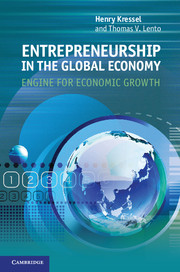Book contents
- Frontmatter
- Contents
- Figures
- Tables
- Acknowledgments
- Introduction
- 1 Government: Boss, financial partner, regulator – Entrepreneurs in mixed economies
- 2 Standing still is not an option: On promoting entrepreneurship and economic growth
- 3 Electronic innovation and the government: David Sarnoff creates the RCA empire
- 4 Global problem, golden opportunity: Ron Stanton profits from market disruption
- 5 Speeding voice and data traffic worldwide: Network microprocessors from RMI
- 6 A world leader emerges: SanDisk and flash memories
- 7 Implementing information technology across the globe
- 8 Three startups in China: Entrepreneurs in a controlled economy
- 9 Connecting the wireless networks of the world
- 10 Building an economy: Government planning vs. entrepreneurial innovation
- Select bibliography
- Index
9 - Connecting the wireless networks of the world
Published online by Cambridge University Press: 05 August 2012
- Frontmatter
- Contents
- Figures
- Tables
- Acknowledgments
- Introduction
- 1 Government: Boss, financial partner, regulator – Entrepreneurs in mixed economies
- 2 Standing still is not an option: On promoting entrepreneurship and economic growth
- 3 Electronic innovation and the government: David Sarnoff creates the RCA empire
- 4 Global problem, golden opportunity: Ron Stanton profits from market disruption
- 5 Speeding voice and data traffic worldwide: Network microprocessors from RMI
- 6 A world leader emerges: SanDisk and flash memories
- 7 Implementing information technology across the globe
- 8 Three startups in China: Entrepreneurs in a controlled economy
- 9 Connecting the wireless networks of the world
- 10 Building an economy: Government planning vs. entrepreneurial innovation
- Select bibliography
- Index
Summary
The money from hauling data, things like video and texts instead of calls, is now 35.9 percent of total service revenue [in the US] … The phone networks carried 341.2 billion megabits of traffic in the first half of 2011, according to the survey, up 111 percent from a year earlier … Talk, meantime, may be falling slightly out of fashion … The average length of a call was 1.83 minutes … As recently as 2007, the average call was near or above three minutes. Who’s got time to talk, when there’s all that video to watch?
Mobile data service is more than a booming business; it is a global phenomenon. Teenagers text each other on their Droids as obsessively as business people check email and corporate data on their iPhone® or BlackBerry® smartphones. TV stations show video clips of everything from cute babies to the rebellion in Libya, captured and sent by people on cell phones. We take it all for granted. Yet none of these capabilities was available as little as a dozen years ago.
Just as remarkably, Aicent, a Silicon Valley startup founded in 2000 by an entrepreneur born in Taiwan, is a world leader in providing the data interconnections among the international wireless carriers that enable these functions across their networks. For example, if you are visiting China or Indonesia and access your emails on your BlackBerry, the chances are that you are using a network connection managed by Aicent.
- Type
- Chapter
- Information
- Entrepreneurship in the Global EconomyEngine for Economic Growth, pp. 210 - 226Publisher: Cambridge University PressPrint publication year: 2012



